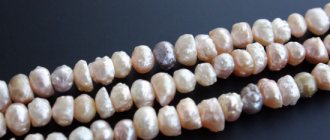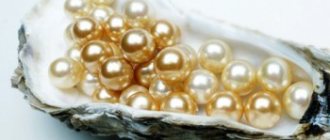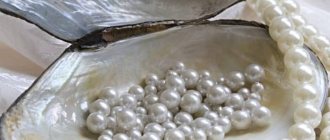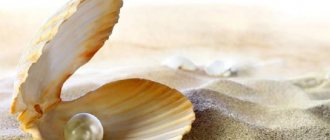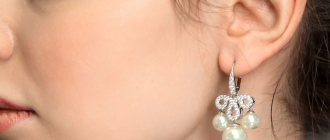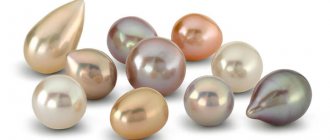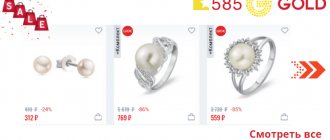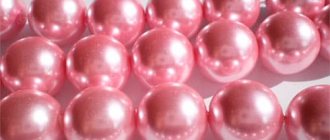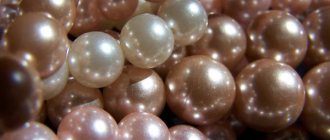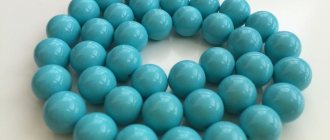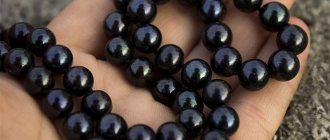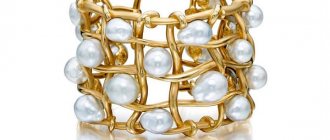However, all the magic happens in the sea, on pearl farms. The oldest is located in the warm waters of the Sulu Sea in the province of Palawan. A tiny island, a piece of paradise, and even smaller, ten minutes by boat, a micro-resort owned by the Brannelak family. Nearby is another one, the headquarters of the Save Palawan Seas Foundation, where poachers are re-educated. Residents of nearby islands are taught to make a living without the use of dynamite and nets. Experts teach everyone to grow bamboo, nuts and vegetables, or raise poultry - without harming the sea surrounding the tiny island farms. To grow first-class pearls, it is necessary to monitor not only the ecology of the tens of kilometers around the farm. Jewelmer even has psychological support specialists on its staff. Oysters require careful treatment, and careful treatment, in turn, requires mental strength, love for one’s work and the simple human happiness of employees. That's why the Brunelacks are willing to invest in it. Do you see what we're getting at? The cost of South Sea pearls consists of very noble expenses.
Before you can grow a pearl, you need to grow the oyster itself. First, marine biologists organize conditions for the reproduction of mollusks. They then monitor the growth of the embryos and provide them with food: the tiny, still translucent oysters must feed on a secret cocktail of phytoplankton in order to grow into individuals with a special golden-hued nacre. Ready for open water and viable young oysters in laboratory tanks are transported by a helicopter attached to the farm. If this still sounds too simple, consider that in the early days of Jewelmer, marine biologists did a lot of work to develop a variety of oysters with golden pearl.
Production technology
By the time the production was actually organized, the man had undergone special training in China, and only after that, in 1999, he was able to begin the practical implementation of his idea.
For a stable relationship and other reasons not to show your wealth to a guy
They're Constantly Chatting and Being Lazy: Five Types of Colleagues Who Are Hindering Your Career
This will expand the circle of consumers: reasons to run an online business
It all starts with collecting freshwater mussels from the streams of the Western Ghats (a mountain range in the west of Hindustan). Then the shell is carefully opened and the pearl core is placed inside. Prepared shellfish are immersed in water at a temperature of 15-25 degrees. Under such conditions, the nuclei become overgrown with several layers of substance produced by shells.
Mathahan uses a small artificial pond with floating buckets to keep the mussels, where the pearls are formed. At the moment, this is a tank 6 m deep, 15 m wide and 30 m long. And since the business is constantly developing, the man has to involve assistants in the production process.
How are pearls grown?
The first stage of pearl cultivation is collecting eggs from pearl oysters. The young mollusks that emerge from it are kept in metal cages with small cells to protect them from attacks by octopuses, starfish and other sea-dwelling enemies. The cages must be periodically cleaned and checked to see if their inhabitants are healthy, and after two years, slightly grown mollusks are transplanted from small cages to large ones. Another year later, when the oysters reach maturity, an operation is carried out to place a grain of mother-of-pearl inside.
The operation is as follows: a small strip of tissue is separated from one oyster. A ball of mother-of-pearl is wrapped in this cloth and placed in the body of another oyster. The mollusk is returned to the sea, and the tissue that was implanted behaves in the same way as the animal’s own cells, secreting nacre that envelops the foreign grain.
The balls that are placed in the oyster are carefully selected in size - they should not be larger than a certain size that the oyster can process. If the grain exceeds a certain maximum size, the oyster may die.
Cages containing pearl oysters are attached to floating buoys connected to each other. The buoys simultaneously hold up to 80 thousand cells. Using motor boats, they are periodically moved to other places to provide food for the oysters. Some types of crustaceans and seaweed pose a threat to the health of oysters, so they are periodically removed from the surface of each shell, then treated with a special composition that prevents the spread of parasites.
Despite all these concerns, some of the oysters die in the first month, and some reject the ball placed in them. The mollusks remaining in the work, and there are less than a third of them, form a couple of millimeters of mother-of-pearl in a few months. It takes at least three years to grow large Akoya pearls.
In modern pearl farms, they are x-rayed and determined whether the pearl is developing inside and, if so, what its diameter is.
The process of growing pearls lasts several years. During this time, oyster processing procedures are regularly carried out, after which beautiful and valuable pearls can finally be extracted.
The percentage of pearl formation even when growing oysters and taking good care of them is very small. It is even more difficult to sort pearls that match each other by size, color, level of shine, and smoothness.
In nature, no two pearls are exactly alike, so sorting pearls is a very complex process that takes a lot of time. Pearls are divided into groups according to size, shape, shade, and brightness of mother-of-pearl, so each pebble is moved many times. After sorting, a hole is carefully drilled into the pearl. It is very important that it is located exactly in the center of the pearl, since even minimal asymmetry can spoil the appearance of a necklace or other jewelry.
After this, identical pearls are selected to make up the jewelry. This is even more painstaking work than sorting: jewelers have to look at the most identical pairs of stones from a group that has already been selected by size, color, shape, brightness, and therefore very similar. Only a specialist with extensive experience can select the perfect pearls for making jewelry. For example, to select 47 absolutely identical pearls for a necklace 42 centimeters long, you have to look through over 10 thousand stones.
Where are irregularly shaped pearls that are not suitable for jewelry purposes used?
They are usually used in the production of medicines, cosmetics and for other purposes - for example, for the production of artificial pearls. Return to list of articles
Golden Harvest
Why do jewelers have a special attraction to Palawan pearls? The answer is simple: local pearls are famous for their unique golden color. The main farm for growing such pearls is called “Taytay” - the same name as the old capital of this group of islands. Much credit for the creation of the farm and the development of technology belongs to the scientist and businessman Jacques Branellec. It was he who came up with the idea of industrial production of “golden” pearls and founded the Franco-Filipino company Jewelmer International Corporation. He managed to attract investors and assembled a team of specialists from different countries. Under the leadership of Jacques, experienced biologists worked for 15 long years before they received the first “golden” pearls. Local shells are distinguished not only by their unique color - they are unusually delicate and capricious. In the early years, with the slightest human intervention in their lives, the mollusks died. In the end, a special technology for growing “golden” pearls was developed. During their ripening, employees perform hundreds of manipulations on the mollusks. They must undergo weekly fluoroscopic examinations to monitor the development of the pearl. In addition, divers must regularly turn over clams located at a depth of fifteen meters to ensure that the pearls ripen more evenly. Farm workers monitor fluctuations in water and air temperatures, as well as the chemical composition of sea water. Data is entered into electronic logs and carefully analyzed. When a pearl oyster is two years old, it is grafted with a tiny part of the shell of another oyster. Over time, a pouch forms around it, from which a “golden” pearl grows. The process of its formation takes an average of five years. Technologies developed over many years bear fruit in the form of an annual harvest of “golden” pearls. Mr. Branellec calls his farm “Pearl Symphony.”
Gift of nature
But what are pearls and how are they formed? This amazing gift of nature is a solid biogenic formation, often having a round shape. Pearls are formed inside the shells of a certain type of mollusk and are the only mineral that is mined not underground, but in the water element. Pearls are characterized by a unique mother-of-pearl shell and resistance to chemical components of the air. The mineral has a unique color palette (white, cream, black, blue and green pearls are found) and pleases the eye with the effect of color iridescence. The most common are spherical varieties of pearls, although oval, pear-shaped or teardrop-shaped ones are also found. But the cost of the specimen increases sharply precisely with its spherical shape.
Swedish version of cultivation
In the 18th century, naturalist Linnaeus tried to improve the Chinese method and achieved some success in this matter. His goal was ideal spherical pearls, which were not always possible to obtain after the introduction of a foreign body into a mollusk.
The scientist has figured out how to control the process of building up layers of mother-of-pearl. He prepared a hole in the top flap of the shell and placed a wire with a tiny limestone ball into it. From time to time he twisted the wire, thus achieving uniform growth of layers of mother-of-pearl. The method has not received recognition due to its complexity.
Intuition and experience
Harvest time is winter. It is believed that at this time of year the layers of mother-of-pearl are the strongest and have a more noble color. Early in the morning, groups of divers go to the depths. Their task is to quickly move ripe mollusks to the surface. Farm employees admit that although the ripening process is under constant control, each time they experience some anxiety and wonder: “What is hiding there - in the body of the pearl oyster?” It is necessary to constantly take into account that she is lively and very capricious, and therefore can present a surprise at any moment. The most important operation in the technological process is extracting the pearl from the body of the mollusk. This action requires constant attention, caution, precision of movements, intuition and a lot of experience. Before opening the shellfish, it is thoroughly washed. At the same time, it is important not to damage his flesh - otherwise he may get sick and die. Only qualified specialists with the appropriate license are allowed to perform this operation.
Preparing the aquarium and choosing mollusks for growing pearls
Pearls can form in the shells of marine mussels and oysters, as well as freshwater mollusks, and can sometimes even be found in the shells of snails and nautiluses.
All of them produce pearls of various sizes, shades and shapes. Determine which type of shellfish is most suitable for keeping in your aquarium. Before you begin cultivating pearls, create a list of needs for the shellfish you choose. It should include specially developed food additives, certain types of plankton necessary for feeding shellfish, and water salinity. Consider whether you can meet all of these requirements, and then negotiate with pet stores to supply the necessary nutrition and nutritional supplements for mussels and oysters.
To grow mussels and oysters, you need a fairly large aquarium, with a minimum volume of 100 liters. From 15 to 20 mollusks can live in such a container. Place a backing on the bottom. To fill the aquarium, use regular tap water, but first let it sit for several days. Add synthetic sea salt according to the instructions, taking into account the required salt concentration for the specific type of shellfish.
You should not add shellfish to the aquarium yet, the water should stand in the container for about two days, add special bacteria to it. During this time, keep the pearl mussels in a plastic tank and then place them on the bottom of the aquarium. Check the salinity and condition of the water regularly over the course of several weeks. If the water takes on an ammonia smell, this means that the bacteria cannot cope with the shellfish by-products, increase the amount of bacteria in the aquarium or reduce the number of shellfish.
Periodically check whether the pearl oysters are alive or not. Touch the sink carefully. Dead mussels and oysters will not close when disturbed. These shellfish should be removed from the aquarium as soon as possible.
Plankton serves as food for mollusks. Add nutritional supplements to it and turn off the filter in the aquarium during feeding. Replace a quarter of the water volume with fresh water monthly.
Underground Halls
A light plane operated by a local airline will take a tourist from the capital of the Philippines, Manila, to the island of Palawan in just over an hour. Billboards placed on the streets of the administrative center of the island - the city of Puerto Princesa - suggest that you first visit the main attraction of the island - an eight-kilometer long underground river. For daredevils who decide to undertake such an adventure, a nimble bus will take you to the town of Sabang in an hour and a half. Local guides will promptly equip everyone with a life jacket, give instructions, seat them on boats and send them to the underground chambers for three hours, where brave guests will receive an unforgettable experience and take exotic photos. And in the southwest of Puerto Princesa, near the city of Quezon, there are still not fully explored Tabon Caves. They are famous for archaeological finds: scientists recently discovered here the remains of prehistoric people who lived fifty thousand years ago. Excavations continue and give archaeologists new surprises every week. Of the 220 caves on the island of Palawan, only three dozen have been explored and equipped for visiting.
The process of pearl generation - where to start
If you did not bring a ready-made kit for growing pearls in an aquarium from Japan, you will have to “introduce” the foreign body into the oyster yourself. This can be done immediately after the mollusks take root in the new place. Try implanting a small mother-of-pearl ball into the mantle of an open mollusk.
When the “processing” is completed, carefully close the pearl oyster and return it to the bottom. You won’t have to do anything further except continue to carefully care for the shellfish. You can check how the “implant” has taken root no earlier than after 3 years.
In conclusion, it remains to be noted that a home aquarium with mussels for creating pearls is not the best option. Those who think about organizing a full-fledged farming of pearl oysters in a natural environment will have much better chances.
We hope that the article was useful and that you made the right conclusions regarding whether it is worth trying to grow pearls at home. Share the material with your friends on social networks!
Team LyubiKamni
Magical and healing qualities
The anthropogenic nature of its appearance does not affect the healing and magical properties of the stone - after all, it is not synthetic, but still a natural formation.
Cultured pearls, like natural ones, are a symbol of femininity, beauty and eternal youth.
Necklace with cultured pearls
Pearls bring a person into a state of mental and physical balance, prolong life and improve its quality, have a beneficial effect on complexion, and help to better withstand heat.
Pearls are an indicator of health - if a person who wears real pearl jewelry for a long time gets sick, the mother-of-pearl surface becomes dull.
This occurs due to changes in the acid-base composition of human sweat.
Water infused with pearls helps with bleeding gums and is useful for conjunctivitis and cholelithiasis. It has a general antimicrobial and hemostatic effect. For women, “pearl water” will help with problems with the menstrual cycle.
Please note: cultured pearls, like ordinary ones, tend to limit a person’s inner freedom, so they can be worn with caution by creative individuals - actors, creators, travelers.
Tourist bait
But still, the Pearl Farm is considered a real attraction for those who come to these places for a short time. It is located north of the Palawan archipelago and consists of half a dozen oyster plantations (each with an area of five thousand hectares). The mountains protect them from destructive winds and currents, and the nearest polluted metropolis, Manila, is separated from the Pearl Farm by five hundred kilometers. The water here is perfectly clean, which is necessary for a special type of local oysters. The golden hue of pearls ripening in delicate oyster bodies is especially valued by jewelers.
Assessment methods
A description of pearls would be incomplete without mentioning the methods of their classification and evaluation. The jewelry community has developed a certain system of concepts and terms that define the meaning of a pearl as the basis for jewelry and a collectible.
Cultured pearls are classified:
- By color. The most common are shades of white and silver, cream, beige, light yellow. Colored ones are valued higher - greenish, steel-gray, red, blue, violet. These are natural specimens, not artificial pearls. Occasionally you come across black pearls, and almost as rare are perfectly white ones.
- By shine. Luster is the main indicator of pearl quality; it depends on the thickness of the nacre layer. The more shiny a pearl is, the more expensive it is (pearls cannot be polished).
- According to the form. The highest value is given to perfectly round pearls that are used for earrings, necklaces or beads. Pear-shaped ones are rated a little lower, and ovoid or oval ones are rated even lower. Baroque pearls stand apart - irregular, distorted shapes, similar to anything, including people and animals.
- To size. The larger the diameter, the more the pearl costs. For each type of pearl, a size range is defined - for example, a regular freshwater one has a minimum diameter of 3 mm, the maximum is 12. But one of the most expensive varieties, “South Sea pearls”, does not allow pearls smaller than 12 mm in diameter, the upper limit is 2 cm and more.
- Mother-of-pearl layer thickness and surface quality. The thicker the layer of mother-of-pearl, the better; for different varieties it varies from 0.1 to 1 mm. The thickness of the mother-of-pearl ensures a play of color on the surface of the jewelry. The surface itself, if it is not a baroque type, should not have any flaws - cracks, depressions, bumps and chips.
Price
For free
Everything that is useful for every tourist on a trip:
- You can find and book tours online at Travelata and Onlinetours.
- You can book and compare hotel prices on Hotellook. And the apartments are on Airbnb.
- You can choose the cheapest air ticket among all airlines on Aviasales.
- Find excursions around the world on Tripster.
- Buy insurance and not worry about your health at Cherehapa.
- Rent a car to see even more interesting places on Economybookings. Or a bike on BikesBooking.
- Book airport transfer Kiwitaxi.
(Visited 138 times, 1 visits today)
WHERE DID THE RUSSIAN PEARLS DISAPPEAR?
In the 18th century, the margaritana population in Russia began to decline sharply, and pearl production decreased. Among the reasons were:
- predatory method of obtaining shells;
- river pollution and waterlogging;
- general deterioration of the environmental situation.
To save shellfish from extermination, in 1721 Emperor Peter I issued a decree to streamline pearl mining in Russia. The collection of mother-of-pearl was prohibited for private individuals. Only holders of state permits could engage in mining.
About ten years later, the right to harvest pearls was returned to private owners. True, they could only keep small stones for themselves; large stones had to be handed over to the treasury for a reward. And in 1764, already in the era of Catherine II, the ban on pearl mining in Russia was completely lifted.
The consequences were not long in coming - by 1860, the fishery began to decline, and the production and export of pearls decreased significantly. They tried to revive the industry, but all the measures being developed did not bring tangible results.
We recommend: RECORD-BREAKING AMBER: expensive, rare, giants
When Russia plunged into an era of coups and revolutions, everyone had no time for gems. After 1917, pearl fishing in the country was considered completely unprofitable.
What types of shellfish to choose
Pearls are formed in the shells of several species of mollusks that live:
- in the seas;
- oceans;
- freshwater lakes;
- rivers and reservoirs.
Depending on the type of living organism, pearls have one or another color, features, and sizes.
Determine which shellfish are suitable for keeping in the aquarium. Consult a biologist.
Japanese akoya shells, for example, are sold in ready-made kits in aquariums, with instructions for growing, food and, most importantly, already “grafted”.
You can buy such sets only in Japan and again, there is no guarantee that they will feel normal at home in Russia. Its price is about $200, the supplements and food included in the package are designed for 60 days, so you will have to look for options for purchasing them separately. The Japanese believe that growing pearls is easy. All you need is suitable conditions and patience with the desire to succeed.
It is believed that pearls can even be obtained from the Black Sea mussel. You don’t have to travel far to get them, and it’s easier to create conditions in the aquarium that are identical to natural ones. But freshwater species of mollusks like Margaritifera Margaritifera will definitely not take root in an aquarium. For normal existence and development, they need a complex of specific microbiotopes of the river, which is almost impossible to recreate artificially.
